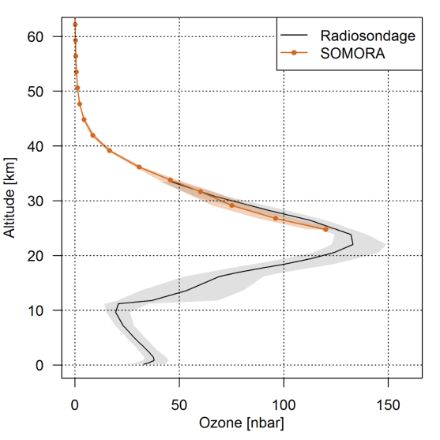Service Navigation
Search
Atmospheric ozone: Benefit and problems
The stratospheric ozone layer is situated at an altitude between 10 and 40 km. The high ozone concentration is capable of almost completely absorbing the harmful shortwave UV radiation of the sun and is therefore vital for the protection of any forms of life on Earth. For example, excessive skin exposure to ultra-violet (high UV index) radiation can cause skin cancer in humans. In contrast, high ozone concentrations at ground level are harmful for humans and nature, because the gas is extremely reactive. This can cause respiratory problems in humans or impaired growth in plants
Is the problem of ozone layer depletion solved?
The answer to this question still has to be „no“. The reasons are the following:
- The ozone layer has not been completely restored; it does not correspond to the state it had achieved prior to 1970, and it is expected to take several decades before this goal is reached.
- The ozone layer depletion at the South Pole (Antarctica) is a recurring yearly phenomenon.
- Ozone depletion was observed at the North Pole (Arctic) for the first time in 2011.
- “Climate change” and the “alteration of the ozone layer” are closely related.
International conventions such as the Montreal Protocol, which was enacted in the late 1980s, ban the use of substances that are harmful to the ozone layer. But even though these agreements are slowly having an effect, the ozone layer continues to be at risk.
Measuring and analysing the ozone development in the different layers of the atmosphere are therefore essential.
Ozone measurements are a Swiss tradition
Measurements of the ozone column
Switzerland has a long history of conducting ozone measurements in the upper atmosphere. As early as 1926, Prof. P. Götz started measuring the ozone levels in Arosa, and these measurements have continued with almost no interruptions ever since. This worldwide unique series of measurements makes it possible to study the development of the ozone layer over a very long period of time.
The figure below clearly shows the ozone depletion at the measurement station of Arosa in the period between 1970 and 1990. The depletion is associated with the use of ozone-depleting substances (called CFCs). The depletion is followed by a period of stabilization and a starting return to pre-1970-values. For comparison, the time series of the yearly lowest measurement at the South Pole station is also shown. There, values are significantly lower because of the annually occurring ozone hole in this area.
The unit used for these measurements is the DU (Dobson Unit). If all the ozone contained in a column of atmosphere were set at the normal conditions (temperature =°C, pressure = 1 bar), its height would be 3 mm if the ozone column is 300 DU.

Ozone profile measurements
MeteoSwiss is using different techniques to measure the vertical ozone profile. Radio soundings allow the measurement in situ of ozone content in the air up to 35 km of altitude. They have been conducted in Payerne since 1968. This uninterrupted series of probes helps us track the development of the ozone quantity in the different atmospheric layers. Since 2000, the microwave instrument SOMORA (Stratospheric Ozone Monitoring Radiometer) measures the ozone mixing ratio from the stratosphere to the lower mesosphere.

Statististical analysis of ozone long-series measurements
The various long series of measurements from MeteoSwiss can be used to calculate the change in ozone concentrations over a long time period. For example over the 1970-1990 period, the ozone layer has decreased by 4%/10 years while the ozone concentration in ambient air has increased by 12%/10 years. Since 2000, the ozone layer is no longer changing significantly but the ozone in ambient air has decreased by 10%/10 years.
- Appenzeller C, AK. Weiss and J. Staehelin (2000), North Atlantic Oscillation modulates total ozone winter trends, Geophys. Res. Let., 27, 1131-1134.
- Weiss AK, J. Staehelin, C. Appenzeller, NRP Harris (2000), Chemical and dynamical contributions to ozone profile trends of the Payerne (Switzerland) balloon soundings, J. Geophys. Res., 106 (D19), p. 22685.
- Staehelin J, NRP Harris, C. Appenzeller, J. Eberhard (2001), Ozone trends: A review, Rev. Geophys., 39 (2), p. 231.
- Jeannet, P., R. Stübi, G. Levrat, P. Viatte, and J. Staehelin (2007), Ozone balloon soundings at Payerne (Switzerland): Reevaluation of the time series 1967–2002 and trend analysis, J. Geophys. Res., 112, D11302, doi:10.1029/2005JD006862.
- Stübi, R., G. Levrat, B. Hoegger, P. Viatte, J. Staehelin, and F. J. Schmidlin (2008), In-flight comparison of Brewer-Mast and electrochemical concentration cell ozonesondes, J. Geophys. Res., 113, D13302, doi:10.1029/2007JD009091.